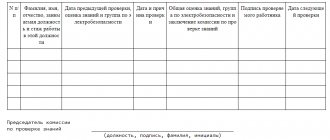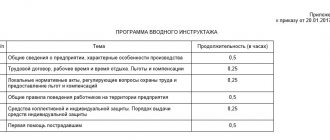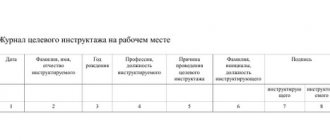It is necessary to remind about compliance with labor protection requirements not only by conducting training and briefings, but also by using labor safety signs.
After all, sometimes it is not enough just to know and remember the rules on labor protection; in order to more effectively preserve the life and health of employees, it is necessary to focus on how to act in a given situation.
For example, a new organization and you, of course, were given instructions and told about everything, but at first there is such a “mess” in your head from the amount of information that you can easily forget something, and when you see the corresponding sign, the employee will be warned. But this is provided that he knows its designation.
And so that workers can easily read occupational health and safety signs, it is necessary to convey this information to them, but often occupational safety specialists do not know all the designations of the signs, for example, beginners.
Therefore, I recommend reading the article to the end and understanding everything. And if you have any questions or have something to add, perhaps I missed some important point, the human factor has not been canceled, write in the comments, we will sort it out.
Labor safety signs
One of the ways to protect personnel, as well as other persons at the site, is the use of occupational safety signs. Their presence is mandatory not only in production, but also in the office, shopping center, and various public spaces.
The main regulatory document defining the rules for placing safety signs is GOST 12.4.026-2015. This is an international standard, observed not only in Russia, but also abroad.
Purpose of safety signs
The main purpose of occupational safety signs is to attract attention, warn of potential danger, and point out something. For the most part, occupational safety signs are plates of various shapes with a pattern on a contrasting background.
Inscriptions are used on them extremely rarely. This is due to the fact that it is necessary to convey information in the simplest and most intuitive form possible. Roughly speaking, a person looked and, even without knowing for sure what safety signs indicate, he can easily guess.
But it’s not enough to guess and assume; you need to clearly know the purpose of each of the signs. And for this it is necessary to conduct lectures on labor protection in the organization, which will reduce the risk of injuries, occupational diseases, and emergency situations.
Effectiveness in reducing injuries can only be achieved through an integrated approach to occupational safety, that is, training, instructions, timely information and warning, namely the use of signs.
But they need to be used wisely; each sign has its own location.
Types of occupational safety signs
There are several approaches to grouping occupational safety signs. The most common classification is by purpose. We will analyze it in more detail below. There are other ways of dividing:
- According to significance, which, in turn, are divided into basic (used independently), additional (only together with another sign) and combined.
- Based on reflectivity, they are divided into non-luminous, reflective or photoluminescent. The last 2 can be installed in low light conditions or intermittent absence of light. These include the “Exit” sign.
- According to their design, they are divided into three-dimensional and flat.
For greater clarity, colors are defined that correspond to certain groups of safety signs, corresponding colors are defined and contrasting white or black colors are used as the background:
- red;
- yellow;
- blue;
- green.
Those signaling danger or prohibiting certain actions are distinguished by bright colors: red or yellow.
Those that are informational in nature are highlighted in blue. Green ones indicate emergency exits and directions in which you need to move to get to safety. These places and the optimal path to them from any point are taken into account at the stage of construction of the facility.
Use of signal colors, safety signs and signal markings
A safety sign is a color graphic image of a certain geometric shape using signal and contrasting colors, graphic symbols and/or explanatory inscriptions, intended to warn people about immediate or possible danger, prohibit, order or permit certain actions, as well as for information about the location of objects and means, the use of which eliminates or reduces the impact of hazardous and/or harmful factors.
Safety signs can be: basic, additional, combined and group.
- Basic safety signs contain an unambiguous semantic expression of safety requirements. Basic signs are used independently or as part of combined and group safety signs.
- Additional safety signs contain an explanatory inscription and are used in combination with the main signs.
- Combined and group safety signs consist of basic and additional signs and are carriers of comprehensive safety requirements.
Safety signs according to the types of materials used can be: non-luminous, retroreflective and photoluminescent; according to design - flat or three-dimensional. Metal, plastic, silicate or organic glass, self-adhesive polymer films, self-adhesive paper, cardboard and other materials are used as carrier materials.
Safety signs are placed (installed) in the field of view of the people for whom they are intended. They are located in such a way that they are clearly visible, do not distract attention and do not create inconvenience when people perform their professional or other activities, do not block the passage, passage, or interfere with the movement of goods.
The main signs are usually divided into the following groups:
- Prohibition signs;
- Warning signs;
- Fire safety signs;
- Mandatory signs;
- Evacuation signs;
- Medical and sanitary signs;
- Directional signs.
The shape of the main safety sign is: circle, triangle, square or rectangle.
Additional safety signs are used in combination with the main signs and are used in cases where it is necessary to clarify, limit or strengthen the effect of the main safety signs, as well as for information. As a rule, additional signs are located below or to the right or left of the main sign. The shape of additional safety signs is a rectangle.
Groups of occupational safety signs
Occupational safety signs are divided into several groups, each of which indicates the severity of exposure to harmful and dangerous factors.
- Occupational health and safety warning signs. They are distinguished by their yellow color, which is clearly visible. They are shaped like a triangle with a black border. Informs about conditions dangerous to life and health and the need to follow rules to avoid unnecessary risks. Examples: “Explosive”, “Load may fall”.
- Prohibitory safety signs on labor protection. They are a black image crossed out with a thick red line on a white background. An action prohibited in the given territory is demonstrated. Examples: “No smoking”, “No entry”.
- Prescriptive safety signs for occupational safety and health. Typically round in shape and blue in color with white trim. Indicate an object or action necessary to complete a task or be in the current zone. Examples: “Wear safety glasses”, “Wear ear protection”.
- Index marks. Rectangular or square in shape and blue in color with an image of a specific location printed in white. Examples: “Eating point”, “Smoking area”.
- Evacuation. Usually rectangular in shape, with a white image on a green background. They can also indicate the location of first aid kits and telephones. Examples: “Exit sign”, “Collection point”.
- Fire safety. A square-shaped safety sign with a pictogram on a red background. In part, it can duplicate evacuation signs, indicating an emergency exit or stairs. Other examples: “Fire extinguisher”, “Fire hydrant”.
Often one sign is not enough to convey maximum information to workers, and in this case, occupational safety signs can be combined into one. They can simultaneously warn, prohibit and prescribe.
For example, one combined sign may prohibit unauthorized persons from visiting a facility, warn about the possibility of exposure to radioactive substances, and require the use of a protective helmet and special suit.
I’m leaving you a link to download signs from different groups and some industries; they can be used not only as a demonstration to workers at a lecture, but also as a layout that can be printed and pasted if funding is tight.
Types of signs
Prohibiting
They are decorated in a red circle with a white field inside, crossed out by an inclined red stripe; in the middle, a forbidden action is graphically depicted in black.
Here are examples of prohibitory safety signs in table form:
| No smoking | Used to indicate areas that may catch fire as a result of smoking. In addition, it is established in connection with the requirements of Federal Law No. 15-FZ dated February 23, 2013 on the ban on smoking in public places (Article 12 of the law directly requires the installation of signs prohibiting smoking). Placed on doors and walls of premises, areas where there are combustible and flammable substances, or in premises, territories and objects where smoking is prohibited. | |
| No entry | Used to designate places with areas hazardous to life and health. Placed at the entrance to hazardous areas, premises, areas, etc. | |
| Pets are prohibited | Used on gates or doors of premises where animals should not be present. |
Occupational Safety and Health Warning Signs
Warning signs are an equilateral triangle with rounded corners, yellow, pointing upward, with a black border.
Here are examples of safety warning signs in table form:
| Carefully. Slippery | Used in areas and areas where there is a risk of slipping. | |
| Dangerous. Toxic substances | Used where toxic substances are stored, released or produced. | |
| Attention. Forklift | Used during unloading and loading operations. |
Mandatory safety signs
Round shape blue.
Examples of such safety signs:
| Work with safety glasses | Used in work areas where vision protection is required. |
| Work in protective clothing | It is used in those workplaces where the use of personal protective equipment is necessary. |
| Passage here | Indicates an area where passage is permitted. |
Fire safety signs
Square shape red. Here are examples of fire safety signs in table form:
| Directional arrow | Used only in conjunction with other fire signs to indicate the direction of movement to fire protection equipment. |
| Fire extinguisher | Located in areas where fire extinguishers are located. |
| Telephone for use in case of fire | It is installed in places where the telephone is located, by which you can call the fire brigade. |
Evacuation and medical and sanitary signs
Square or rectangular green.
Examples:
| Direction to the emergency exit down the stairs | Installed on landings and walls adjacent to them. |
| First aid kit | Placed on the walls and doors of rooms to indicate the location of the first aid kit. |
| Medical office | Located on the doors of medical rooms. |
Size and location of occupational safety signs
GOST regulates the clear size of safety signs, a specific placement point and the maximum distance at which it should be visible.
The indicated dimensions correspond to conditions with optimal illumination for the human eye. And when placing a safety sign, it is worth considering:
- its visibility from different points of the room;
- height above the surface. It is advisable to hang the sign at eye level or slightly higher;
- the safety sign should not prevent employees from performing their duties.
First of all, occupational health and safety signs are installed for the convenience and safety of those on the premises. Therefore, even in the absence of checks, they must be well lit and unobstructed, and also fully correspond to reality. If one of the emergency exits is closed or something else has changed, the signs are changed to the current ones.
Samples
We present occupational safety signs in pictures as samples. For this we use the already familiar table:
| View | Sample |
| Prohibiting | |
| Warning | |
| Fire safety signs | |
| Prescriptive | |
| Evacuation | |
| Medical and sanitary purposes | |
| Index fingers | |
| Combined | |
| Group |
Responsibility for the absence of safety signs
For failure to comply with safety rules, the employer faces a fine, including if there are no occupational safety signs. According to Art. 5.27.1 of the Code of Administrative Offenses of the Russian Federation, the fine for the absence of at least 1 required sign is up to 80,000 rubles.
And the fact of the presence of signs is recorded in a special journal; this requirement is not mandatory, but recommended. During inspections, their presence and correct placement is one of the mandatory points that inspectors pay attention to.
Basic safety signs
Prohibition signs
Shape
Circle
Color
Red
Meaning
Prohibition of dangerous behavior or activity
Warning signs
Form
Triangle
Color
Yellow
Meaning
Warning of possible danger, requirement of caution, attention
Mandatory signs
Form
Triangle
Color
Blue
Meaning
Prescription of mandatory actions to avoid danger
Fire safety signs
Form
Square and rectangle
Color
Red
Meaning
Designation and indication of locations of fire protection equipment and their elements
Evacuation signs
Form
Square and rectangle
Color
Green
Meaning
Indication of the direction of movement during evacuation
Medical signs
Form
Square
Color
Green
Meaning
Designation of first aid points
Directional signs
Form
Square and rectangle
Color
Blue
Meaning
Indicating places, allowing actions
Electrical safety signs
Form
Square and rectangle
Color
Red and blue
Meaning
Warns about possible dangers and precautions during work
Main conclusions
It would seem that what a trifle the pictures on the wall are - occupational safety signs, but if it is not there or the wrong one is pasted, it could cost a person’s life or health.
And as they say, ignorance does not exempt us from responsibility, and in this matter, if they didn’t know that they needed to stick a sign, administrative liability is possible.
Therefore, you should not brush it off and figure out what groups and types of occupational safety signs exist, what they mean and in what case they are applied. Check the need for them in your organization, and give a lecture to the staff so that they are also aware.
If you liked my article, you can share it in the comments, it will please me and encourage me to write even more useful and interesting notes on occupational safety. And if you need help, please contact me, I will definitely help.
I wish you safe and efficient work!
Signal colors
For ease of use and clarification of the meaning of each type of sign, the law provides for their division by color depending on their affiliation:
- prohibiting ones are highlighted with a strictly red circle with a red crosshair. Also, an object or action subject to prohibition is highlighted in black;
- indicative – indicated by a blue background with a white indication;
- fire and electrical safety – highlighted with a red background with white indicators;
- warning - highlighted with a yellow background with a black border and a black indication;
- medical - indicated by a green background with white indicators;
- evacuation – highlighted with a green background with white signs;
- prescriptive - marked with a blue background with white indicators.
Prohibiting
Prohibitory signs on labor protection are the strictest of all types, as they prohibit an employee of an organization from carrying out any activity.
This type is mandatory for all employees of the enterprise, regardless of position.
The essence is the prohibition to carry out actions or use certain methods of performing work duties.
The most common prohibitory pictures include a ban on smoking indoors, a ban on passage, a ban on using equipment, parking with the engine running, using a fire extinguisher, eating food, and others.
Necessary to prevent an emergency.
Prescriptive
Mandatory signs are also valid for all employees of the organization and, accordingly, require them to perform certain actions to comply with working conditions and safety standards.
The most common signs in this category include indicating a smoking area, wearing a helmet in a certain area, wearing protective gloves, a suit, turning off equipment during work, using headphones or a gas mask.
Necessary for proper work performance in accordance with labor safety standards.
Warning
Warning signs indicate hazardous working conditions or other negative factors that may occur during work activities.
These include the danger of voltage, fire, explosion, collapse, ground slope, radiation or biological contamination, narrowing of the road, danger of a landslide or avalanche, the presence of toxic substances, magnetic or electromagnetic fields.
Index fingers
Indicative signs serve to inform the organization’s personnel about the location of certain areas during a break or end of the work process, such as a picture indicating a place for eating, a smoking area, a place with drinking water.
They serve to simplify production activities and provide convenience to the organization’s employees.
Download pictures of signs with explanations
Basic safety signs for labor protection in pictures with explanations –.
Production and sale of safety signs
Main area of activity. Depending on the types of materials used, we produce non-luminous, retroreflective and photoluminescent signs. Reliable materials are used for production, including galvanized and cold-rolled metal, non-flammable plastic, self-adhesive film with photoluminescent coating.
From us you can buy safety signs in Moscow with delivery anywhere in Russia. Products are manufactured in accordance with GOST requirements.
Catalogs
Certificates
REGULATORY REQUIREMENTS OF LEGISLATION
GOST 12.4.026-2015. System of occupational safety standards. Signal colors, safety signs and signal markings. Purpose and rules of use. General technical requirements and characteristics. Test methods
GOST 14202-69 “Pipelines of industrial enterprises. Identification markings, warning signs and markings
GOST ISO 3864-1-2013 Graphic symbols. Signal colors and safety signs. Part 1. Principles for designing signs and signal markings
GOST R 12.2.143-2009 System of occupational safety standards (SSBT). Photoluminescent evacuation systems. Requirements and control methods (with Amendment No. 1)











